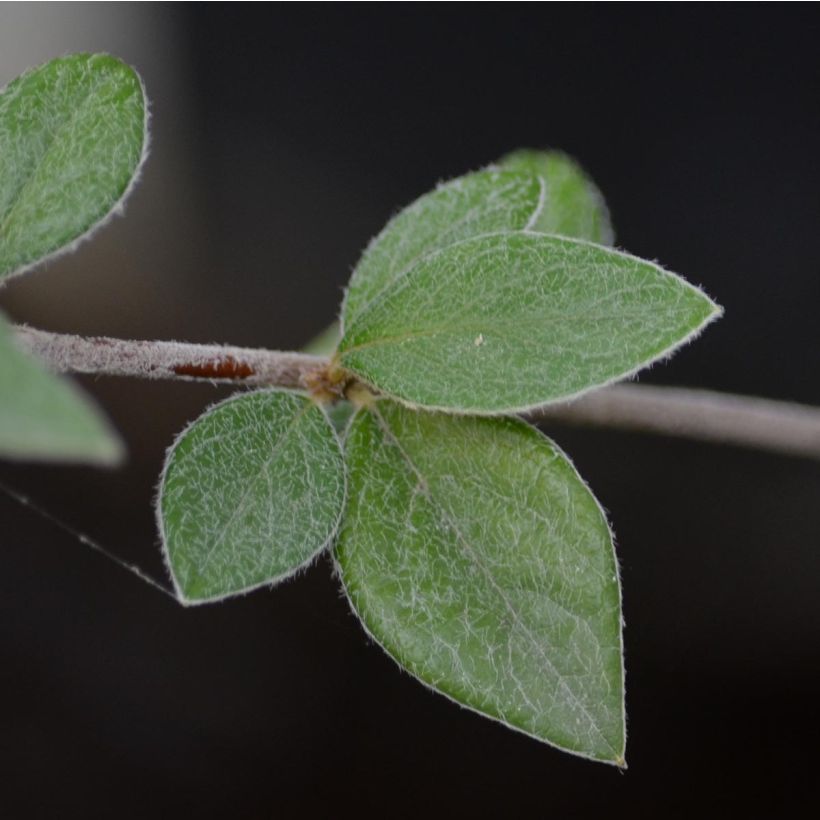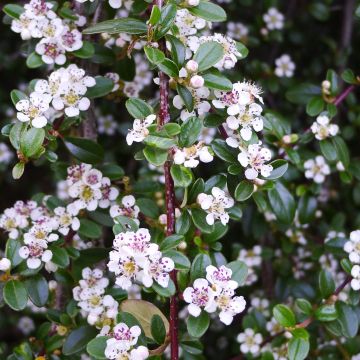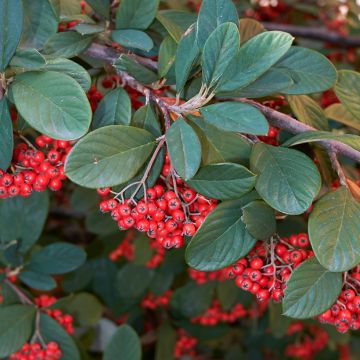

Cotoneaster franchetii


Cotoneaster franchetii


Cotoneaster franchetii


Cotoneaster franchetii
View more pictures
Hide images

Catherine F.

Catherine F. • 50 FR
Cotoneaster franchetii
Cotoneaster franchetii
Franchet's Cotoneaster
Very disappointed. The cotoneaster has no more leaves, it looks very dry, it doesn't bode well for recovery.
Julien , 25/02/2025
Special offer!
Receive a €20 voucher for any order over €90 (excluding delivery costs, credit notes, and plastic-free options)!
1- Add your favorite plants to your cart.
2- Once you have reached €90, confirm your order (you can even choose the delivery date!).
3- As soon as your order is shipped, you will receive an email containing your voucher code, valid for 3 months (90 days).
Your voucher is unique and can only be used once, for any order with a minimum value of €20, excluding delivery costs.
Can be combined with other current offers, non-divisible and non-refundable.
Home or relay delivery (depending on size and destination)
Schedule delivery date,
and select date in basket
This plant carries a 24 months recovery warranty
More information
We guarantee the quality of our plants for a full growing cycle, and will replace at our expense any plant that fails to recover under normal climatic and planting conditions.

Would this plant suit my garden?
Set up your Plantfit profile →
Description
The Cotoneaster franchetii, also known as the Franchet's Cotoneaster, is a hardy bush that grows quickly, is not very demanding, and tolerates pruning very well. These qualities make it useful in natural or trimmed hedges, where its dense and evergreen growth in winter works wonders. It is also interesting for its abundant white-pink flowering, which is very attractive to bees, followed by numerous red-orange berries that remain decorative in autumn and winter. It is easily grown in full sun or partial shade, in any good garden soil that is not too dry in summer.
The Cotoneaster franchetii is a bush from the rose family, just like its cousins the pyracanthas. It originates from western China and Tibet, where it is found growing on forest edges, sometimes on rocky slopes. Very tolerant, this cotoneaster dislikes dry summers and north-facing exposures. It grows quickly, naturally developing a slightly unkempt habit, wider than it is tall, and will reach an average height of 3m (9.8ft) and a spread of 3.50m (11.5ft) if not limited by pruning.
Its habit is fairly upright to spreading, bushy, irregular, arched and well-branched. The young branches are hairy and then become smooth and brown. It flowers in May and June for several weeks, in the form of numerous corymbs that comprise 5 to 15 fragrant flowers. These are small flowers, 6 to 7mm (0.3in) in diameter, of a white-pink colour. The flowers are followed by fruits, which ripen in September-October. These are round berries, 6 to 9mm (0.4in) in diameter, both decorative and sought after by birds.
The foliage of this bush is evergreen to semi-evergreen depending on the severity of the winter. It is composed of small ovate and pointed leaves, 2 to 4cm (1.6in) long. They are matte green on the upper side and their undersides are velvety and silvery white.
The scent of the flowers contributes to the plant being honey-bearing, meaning it contains substances collected by bees that they will transform into honey. The Cotoneaster franchetii can be used in shrub beds and natural or trimmed hedges. For example, it is a good border plant to be placed in front of a grove of tall trees. Combine it with pyracanthas, bay laurels, Cotoneaster lacteus, Elaeagnus ebbingei, Photinias, and cherry laurels in a large evergreen, windbreak hedge that will provide shelter and cover for all the small fauna in the garden. It can also be a beautiful specimen plant if pruned into a ball shape at the corner of a bed or at the end of a pathway.
Report an error about the product description
Cotoneaster franchetii in pictures




Plant habit
Flowering
Foliage
Botanical data
Cotoneaster
franchetii
Rosaceae
Franchet's Cotoneaster
China
Other Cotoneaster
View all →Planting and care
Position the Cotoneaster franchetii in a sunny location to promote abundant flowering. It can also be placed in a semi-shaded area. It only dislikes north-facing exposures. Plant it in ordinary (even chalky or rocky), moist but well-drained soil that is moderately fertile. You can plant it at any time of the year except during freezing, hot, and dry periods. This Franchet's cotoneaster dislikes excessively dry summers. Protect it from cold and drying winds in regions with harsh winters. Cotoneaster franchetii can be attacked by scale insects, aphids, and caterpillars. Fire blight and root rot are disease risks.
Planting period
Intended location
Care
-
, onOrder confirmed
Reply from on Promesse de fleurs
Similar products
Haven't found what you were looking for?
Hardiness is the lowest winter temperature a plant can endure without suffering serious damage or even dying. However, hardiness is affected by location (a sheltered area, such as a patio), protection (winter cover) and soil type (hardiness is improved by well-drained soil).

Photo Sharing Terms & Conditions
In order to encourage gardeners to interact and share their experiences, Promesse de fleurs offers various media enabling content to be uploaded onto its Site - in particular via the ‘Photo sharing’ module.
The User agrees to refrain from:
- Posting any content that is illegal, prejudicial, insulting, racist, inciteful to hatred, revisionist, contrary to public decency, that infringes on privacy or on the privacy rights of third parties, in particular the publicity rights of persons and goods, intellectual property rights, or the right to privacy.
- Submitting content on behalf of a third party;
- Impersonate the identity of a third party and/or publish any personal information about a third party;
In general, the User undertakes to refrain from any unethical behaviour.
All Content (in particular text, comments, files, images, photos, videos, creative works, etc.), which may be subject to property or intellectual property rights, image or other private rights, shall remain the property of the User, subject to the limited rights granted by the terms of the licence granted by Promesse de fleurs as stated below. Users are at liberty to publish or not to publish such Content on the Site, notably via the ‘Photo Sharing’ facility, and accept that this Content shall be made public and freely accessible, notably on the Internet.
Users further acknowledge, undertake to have ,and guarantee that they hold all necessary rights and permissions to publish such material on the Site, in particular with regard to the legislation in force pertaining to any privacy, property, intellectual property, image, or contractual rights, or rights of any other nature. By publishing such Content on the Site, Users acknowledge accepting full liability as publishers of the Content within the meaning of the law, and grant Promesse de fleurs, free of charge, an inclusive, worldwide licence for the said Content for the entire duration of its publication, including all reproduction, representation, up/downloading, displaying, performing, transmission, and storage rights.
Users also grant permission for their name to be linked to the Content and accept that this link may not always be made available.
By engaging in posting material, Users consent to their Content becoming automatically accessible on the Internet, in particular on other sites and/or blogs and/or web pages of the Promesse de fleurs site, including in particular social pages and the Promesse de fleurs catalogue.
Users may secure the removal of entrusted content free of charge by issuing a simple request via our contact form.
The flowering period indicated on our website applies to countries and regions located in USDA zone 8 (France, the United Kingdom, Ireland, the Netherlands, etc.)
It will vary according to where you live:
- In zones 9 to 10 (Italy, Spain, Greece, etc.), flowering will occur about 2 to 4 weeks earlier.
- In zones 6 to 7 (Germany, Poland, Slovenia, and lower mountainous regions), flowering will be delayed by 2 to 3 weeks.
- In zone 5 (Central Europe, Scandinavia), blooming will be delayed by 3 to 5 weeks.
In temperate climates, pruning of spring-flowering shrubs (forsythia, spireas, etc.) should be done just after flowering.
Pruning of summer-flowering shrubs (Indian Lilac, Perovskia, etc.) can be done in winter or spring.
In cold regions as well as with frost-sensitive plants, avoid pruning too early when severe frosts may still occur.
The planting period indicated on our website applies to countries and regions located in USDA zone 8 (France, United Kingdom, Ireland, Netherlands).
It will vary according to where you live:
- In Mediterranean zones (Marseille, Madrid, Milan, etc.), autumn and winter are the best planting periods.
- In continental zones (Strasbourg, Munich, Vienna, etc.), delay planting by 2 to 3 weeks in spring and bring it forward by 2 to 4 weeks in autumn.
- In mountainous regions (the Alps, Pyrenees, Carpathians, etc.), it is best to plant in late spring (May-June) or late summer (August-September).
The harvesting period indicated on our website applies to countries and regions in USDA zone 8 (France, England, Ireland, the Netherlands).
In colder areas (Scandinavia, Poland, Austria...) fruit and vegetable harvests are likely to be delayed by 3-4 weeks.
In warmer areas (Italy, Spain, Greece, etc.), harvesting will probably take place earlier, depending on weather conditions.
The sowing periods indicated on our website apply to countries and regions within USDA Zone 8 (France, UK, Ireland, Netherlands).
In colder areas (Scandinavia, Poland, Austria...), delay any outdoor sowing by 3-4 weeks, or sow under glass.
In warmer climes (Italy, Spain, Greece, etc.), bring outdoor sowing forward by a few weeks.


















































